What Does a 5 Pointed Star Symbolize Spiritually? Explain!
The 5 pointed star, commonly known as the pentagram, is a symbol with a rich spiritual significance that varies across cultures and religions.
In many spiritual beliefs, the pentagram represents the four elements of earth, air, fire, and water, with the fifth point symbolizing the spirit or the self. It is also associated with protection against evil and is a symbol used in various magical practices.
The pentagram has been used since ancient times and holds different meanings in spiritual and esoteric traditions:
The five-pointed star serves as a beacon of spiritual balance, reminding us of the interconnection between the physical world and the ethereal realm.
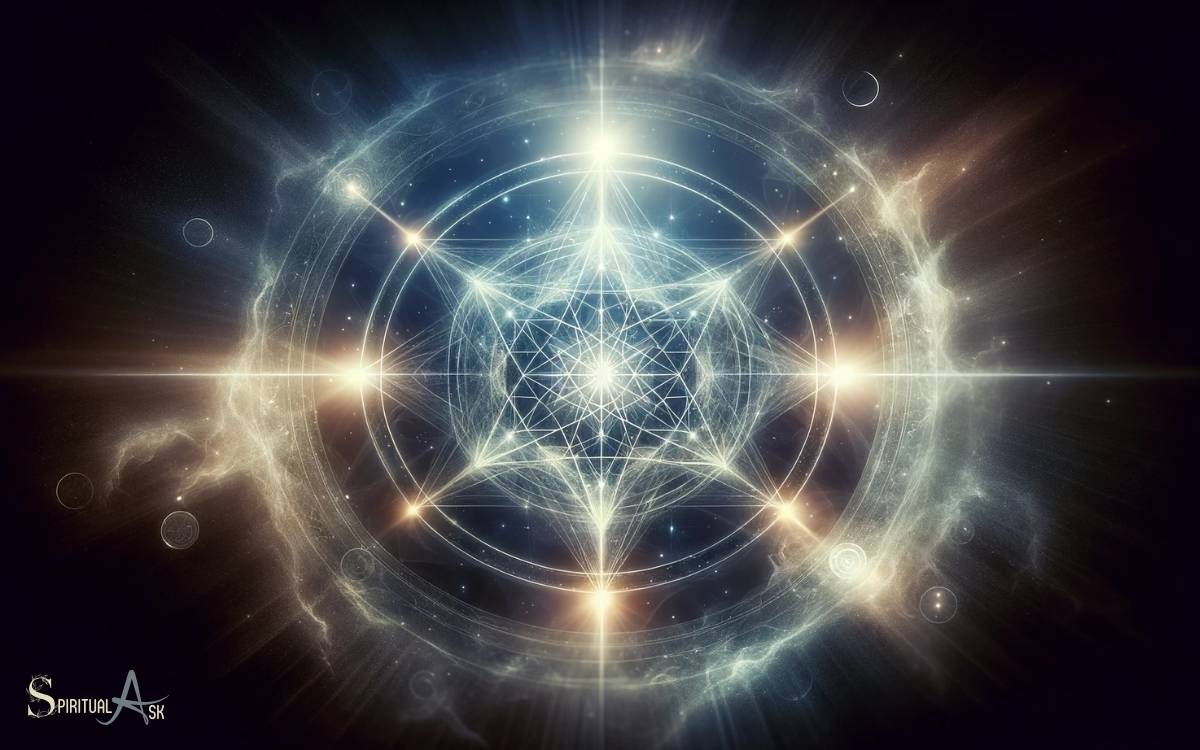
Key Takeaway
Ancient Symbolism of the Pentagram

In my research, I’ve found that the ancient symbolism of the pentagram is fascinating and complex. The pentagram has been imbued with various meanings throughout history.
- In ancient Mesopotamia, it represented the five visible planets and was associated with divine protection.
- In Pythagorean philosophy, it symbolized the harmony of the five elements – earth, air, fire, water, and spirit.
- In medieval Christian symbolism, the five points were linked to the wounds of Christ and the five senses.
Additionally, the upward point represented the spirit rising above matter. The pentagram also holds significance in Wiccan and pagan traditions, where it embodies the five elements and is often used in protective rituals.
This rich history reveals the pentagram as a symbol with deep spiritual connotations across different cultures and time periods.
Five Elements and the Pentagram

I’ve always been fascinated by the symbolism of the five elements and how they relate to the pentagram. The points of the star representing earth, air, fire, water, and spirit hold great spiritual significance.
Understanding the elemental symbolism in the pentagram can provide valuable insights into its spiritual meaning.
Elemental Symbolism in Pentagram
As a practitioner, my understanding of the five-pointed star, or pentagram, is deeply rooted in its elemental symbolism, which associates each point with one of the five classical elements.
The upward point represents spirit or ether, while the remaining four points signify earth, air, fire, and water.
These elements hold significant spiritual and symbolic meaning, representing the fundamental forces of nature and aspects of the human experience.
Earth embodies stability and grounding, air symbolizes intellect and communication, fire represents transformation and passion, and water signifies emotions and intuition.
The pentagram’s elemental symbolism reflects a holistic view of existence, integrating the physical and metaphysical realms.
Understanding these elemental associations enhances the depth of spiritual practices and rituals involving the pentagram, allowing for a harmonious connection with the natural world and the divine.
Spiritual Significance of Pentagram
Why does the five-pointed star symbolize spiritually, and how do the five elements intertwine with the pentagram’s spiritual significance?
The pentagram holds deep spiritual meaning, with each of its five points representing an element – earth, air, fire, water, and spirit. These elements are fundamental to life and are interconnected with the human experience.
Earth signifies stability and physical endurance, air represents intellect and communication, fire embodies passion and transformation, water symbolizes emotions and intuition, while the upward point of the star denotes spirit, connecting all the elements.
The pentagram thus serves as a symbol of balance and harmony between these elements, reflecting their presence not just in the physical world, but also within ourselves.
Understanding the spiritual significance of the pentagram can offer insights into the interconnectedness of nature, spirit, and the self.
Spiritual Significance in Wicca
I’ll start by highlighting the significance of the points in Wicca. The five points of the pentacle represent the elements and directions in Wiccan beliefs, each holding its own spiritual significance.
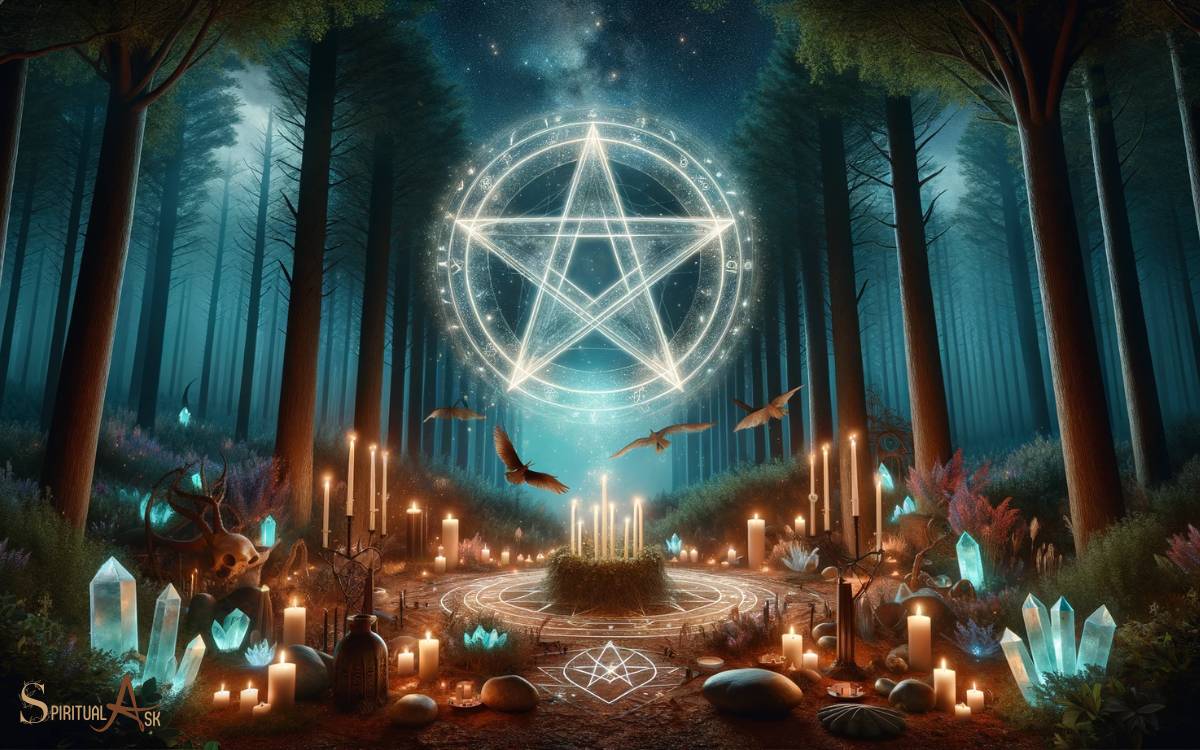
Understanding the role of these points is essential in grasping the deeper meaning behind the pentagram in Wicca.
Wiccan Pentacle Symbolism
In Wicca, the pentacle symbolizes the five elements of earth, air, fire, water, and spirit, representing the interconnectedness of these elements in spiritual practice.
- Earth: symbolizes stability, foundation, and the physical realm.
- Air: represents intellect, communication, and the powers of the mind.
- Fire: embodies transformation, passion, and the energy of creation and destruction.
- Water: signifies emotions, intuition, and the subconscious mind.
- Spirit: represents the divine, the interconnectedness of all things, and the energy that permeates the universe.
Understanding the symbolism of the pentacle in Wicca helps practitioners connect with the natural world and the spiritual forces at work within and around them.
This interconnectedness is further reflected in how the elements are associated with specific directions, adding depth to the spiritual practice.
Elements and Directions
As a Wiccan practitioner, my understanding of the elements and their association with specific directions holds significant spiritual significance.
In Wicca, the elements of earth, air, fire, and water are closely linked to the directions of north, east, south, and west, respectively.
Earth is associated with the north, representing stability and abundance. Air corresponds to the east, symbolizing intellect and communication.
Fire relates to the south, embodying passion and transformation. Water is tied to the west, signifying emotions and intuition.
Understanding these elemental correspondences aids in spiritual rituals and spellwork, helping to harness the energies present in different directions.
This interconnectedness between elements and directions fosters a deeper connection to nature and the divine.
Such understanding allows Wiccans to work in harmony with the natural world and the spiritual forces that guide it.
In understanding the elements and their associations with directions, we gain insight into the deeper spiritual significance of the pentagram in Wicca. This serves as a foundation for exploring its representation in the alchemical tradition.
Pentagram in Alchemical Tradition
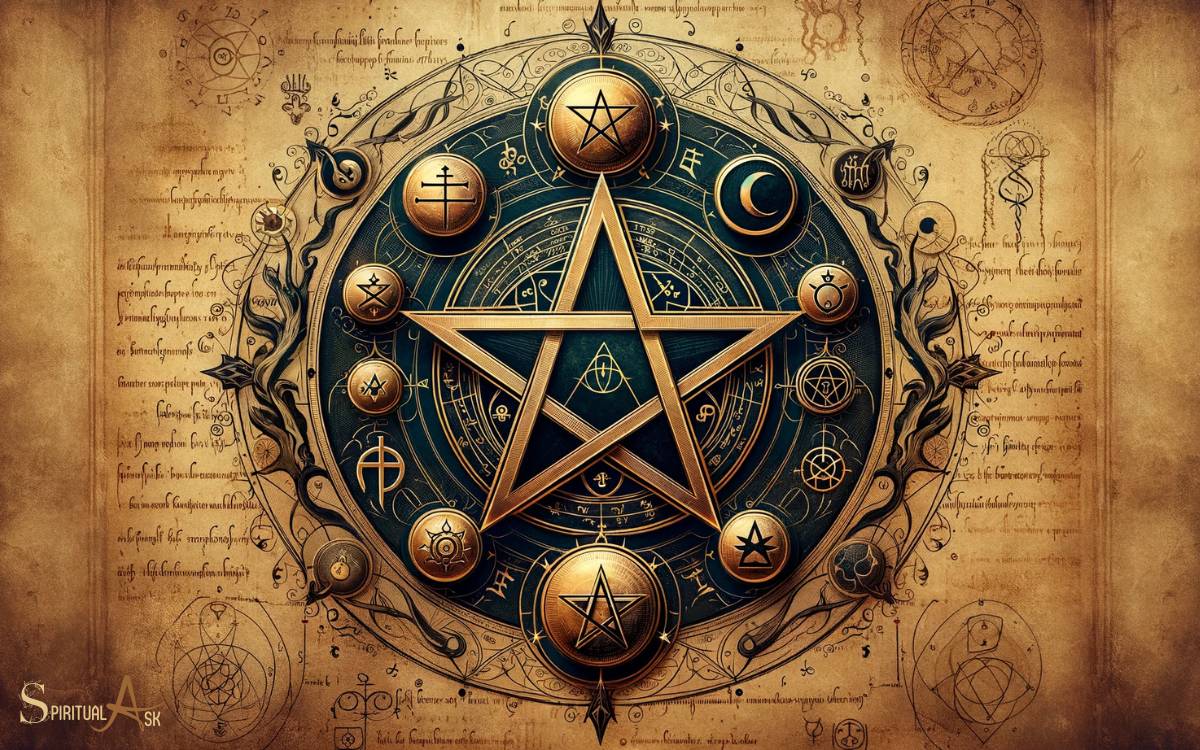
The pentagram holds a prominent place in alchemical tradition, representing the integration of the four elements and the spiritual fifth element.
In alchemy, the pentagram signifies the union of spiritual and material realms, and the interconnectedness of all things.
Here’s a breakdown of the symbolism:
- Earth: Symbolizes stability and physical manifestation.
- Air: Represents intellect, communication, and the realm of thought.
- Fire: Signifies transformation, passion, and the driving force of change.
- Water: Symbolizes intuition, emotions, and the subconscious mind.
- Spirit: Represents the divine, the ethereal, and the interconnectedness of all elements.
Understanding the pentagram in alchemical tradition provides insight into the interconnected nature of the elements and their spiritual significance.
Esoteric Meaning in Hermeticism
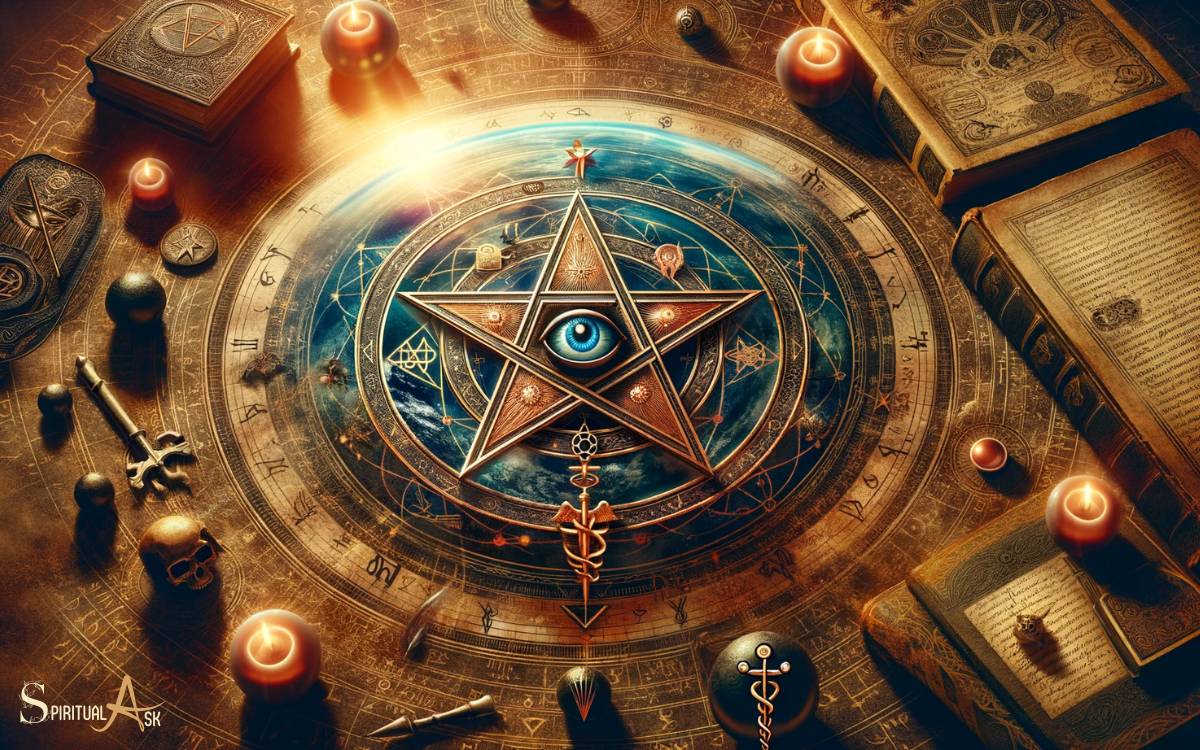
Continuing from the previous subtopic, my exploration of the pentagram’s symbolism in alchemical tradition leads me to delve into its esoteric meaning in Hermeticism. In Hermeticism, the pentagram represents the microcosm of the human being.
Each of the five points corresponds to the elements of earth, water, air, fire, and spirit, symbolizing the harmony and balance of these elements within the individual.
The upward point signifies the spirit ruling over the four elements of matter, reflecting the Hermetic principle of the spiritual dominating the material.
Additionally, the pentagram embodies the concept of the divine within humanity, portraying the connection between the earthly and the divine.
Hermeticists view the pentagram as a symbol of spiritual evolution and the journey towards self-realization, emphasizing the interconnectedness of the cosmos and the individual.
Pentagram in Abrahamic Faiths
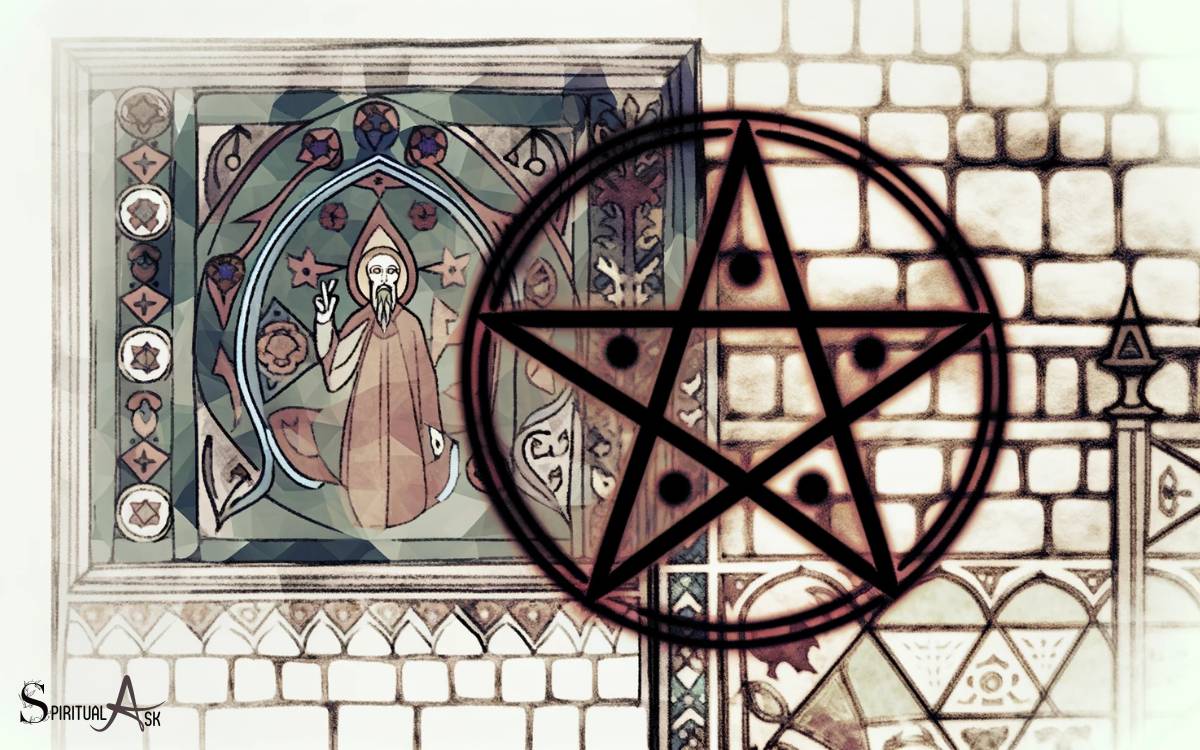
Exploring the significance of the pentagram in Abrahamic faiths reveals its diverse interpretations and associations.
In the context of Abrahamic religions, the pentagram holds various meanings:
- Christianity: In Christian symbolism, the five points of the pentagram are often associated with the five wounds of Christ, signifying his crucifixion and ultimate sacrifice for humanity.
- Judaism: Some Jewish mystics interpret the pentagram as a representation of the five books of the Torah, emphasizing its significance as a symbol of divine wisdom and guidance.
- Islam: Within Islamic mysticism, the pentagram can be linked to the five pillars of Islam, representing the core principles and practices of the faith.
- Baha’i Faith: Followers of the Baha’i Faith view the pentagram as a symbol of the five fundamental spiritual principles that form the foundation of their beliefs.
- Druze: The Druze community incorporates the pentagram into their religious symbolism, associating it with the five prophets revered in their tradition.
Cosmic Connection and Sacred Geometry
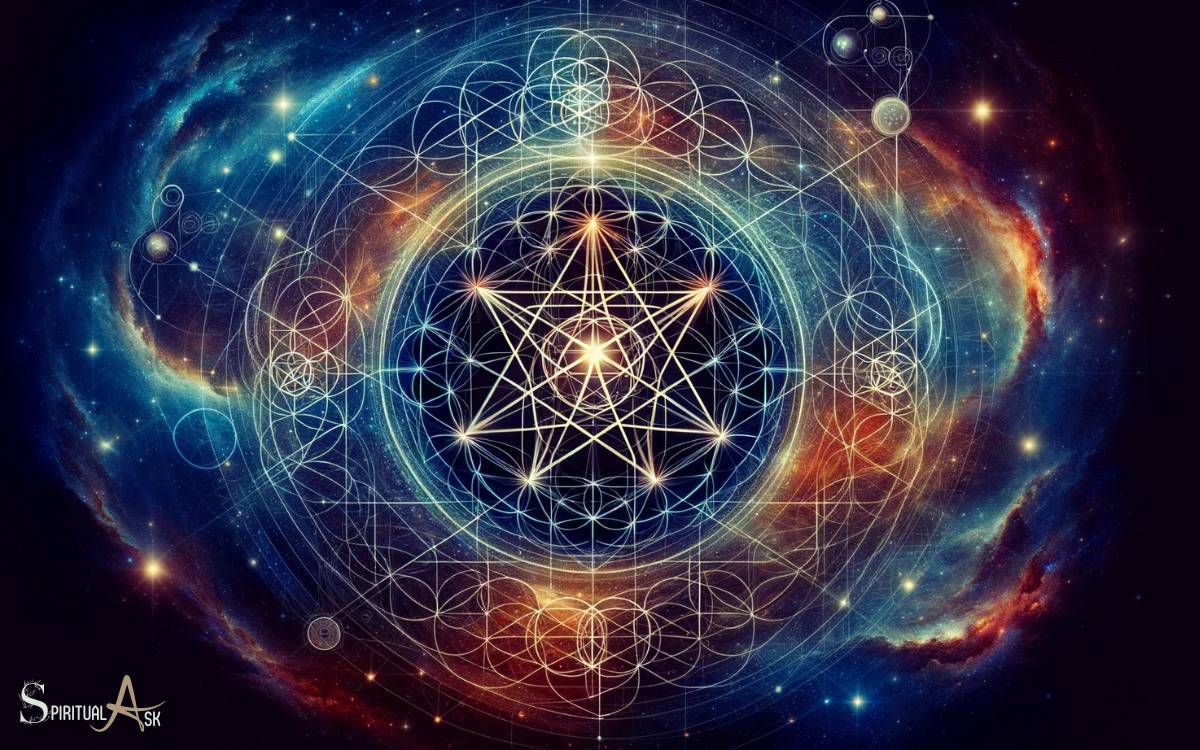
Immersed in the study of cosmic connections and sacred geometry, one discovers the profound interplay between the spiritual and the cosmic dimensions.
Sacred geometry, such as the five-pointed star, reflects the interconnectedness of all things in the universe.
The five points of the star symbolize the five elements – earth, air, fire, water, and spirit – and their harmonious coexistence. This geometric symbol also represents the divine balance and unity within the cosmos.
Through sacred geometry, we can perceive the fundamental patterns that underlie existence, fostering a deep appreciation for the cosmic order.
The interconnectedness of these geometric forms with spiritual principles serves as a reminder of our place within the universe and our connection to the divine.
Understanding these cosmic connections through sacred geometry can enrich our spiritual journey and deepen our sense of unity with the cosmos.
Modern Interpretations and Misconceptions
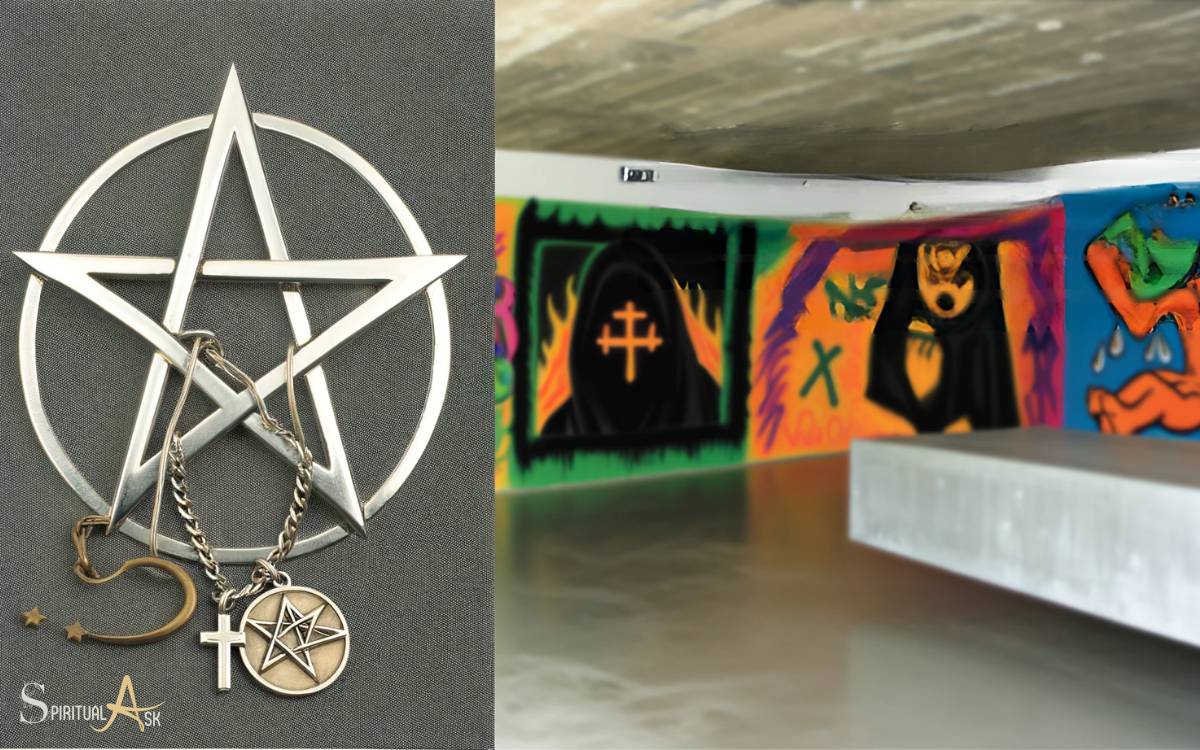
I frequently encounter modern interpretations and misconceptions about the spiritual symbolism of the five-pointed star. It’s important to address these to foster a deeper understanding of its significance. The spiritual symbolism of stars has roots in various cultures, representing concepts such as guidance, protection, and divine energy. The five-pointed star, often associated with the pentagram, holds particular significance in Wiccan and pagan traditions, representing the elements of earth, air, fire, water, and spirit. Understanding the true meaning behind these symbols can help dispel misconceptions and allow for a more accurate interpretation of their spiritual significance.
Here are some common modern interpretations and misconceptions:
- The belief that the five-pointed star represents evil or dark magic, when in reality it has a rich history of symbolizing protection and guidance.
- The misconception that the star is exclusively associated with one particular religion, neglecting its presence in various spiritual and cultural traditions.
- The modern interpretation that the star has no relevance in today’s society, dismissing its continued use as a symbol of inspiration and aspiration.
- The misconception that the five points of the star represent the basic elements of earth, air, fire, water, and spirit, overlooking its more complex and varied meanings.
- The modern interpretation that the star is solely a patriotic or political symbol, disregarding its deeper spiritual connotations throughout history.
Conclusion
The 5 pointed star, also known as the pentagram, holds a rich spiritual significance across various traditions and cultures.
Its representation of the five elements, cosmic connection, and sacred geometry makes it a powerful symbol in Wicca, alchemical tradition, Hermeticism, and even in Abrahamic faiths.
As we continue to explore its ancient symbolism and modern interpretations, we might just find that the pentagram’s spiritual significance aligns with our own beliefs and experiences. It’s all about the magic of coincidence.






